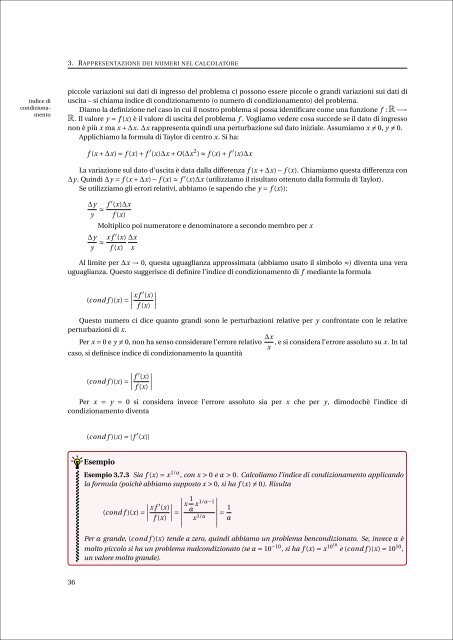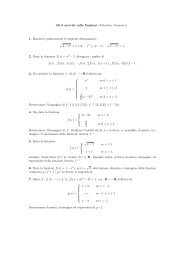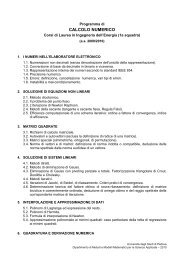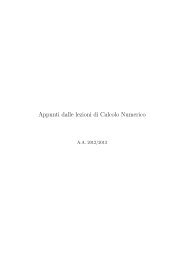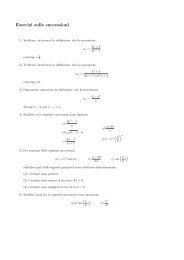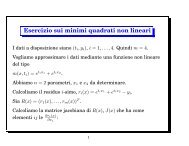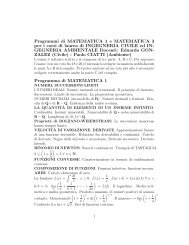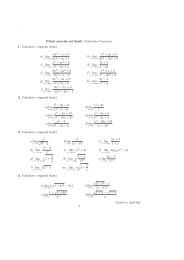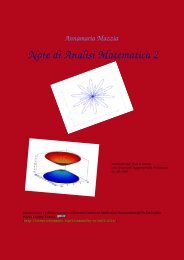Appunti di Calcolo Numerico - Esercizi e Dispense - Università degli ...
Appunti di Calcolo Numerico - Esercizi e Dispense - Università degli ...
Appunti di Calcolo Numerico - Esercizi e Dispense - Università degli ...
Create successful ePaper yourself
Turn your PDF publications into a flip-book with our unique Google optimized e-Paper software.
3. RAPPRESENTAZIONE DEI NUMERI NEL CALCOLATORE<br />
in<strong>di</strong>ce <strong>di</strong><br />
con<strong>di</strong>zionamento<br />
piccole variazioni sui dati <strong>di</strong> ingresso del problema ci possono essere piccole o gran<strong>di</strong> variazioni sui dati <strong>di</strong><br />
uscita – si chiama in<strong>di</strong>ce <strong>di</strong> con<strong>di</strong>zionamento (o numero <strong>di</strong> con<strong>di</strong>zionamento) del problema.<br />
Diamo la definizione nel caso in cui il nostro problema si possa identificare come una funzione f : R −→<br />
R. Il valore y = f (x) è il valore <strong>di</strong> uscita del problema f . Vogliamo vedere cosa succede se il dato <strong>di</strong> ingresso<br />
non è più x ma x + ∆x. ∆x rappresenta quin<strong>di</strong> una perturbazione sul dato iniziale. Assumiamo x ≠ 0, y ≠ 0.<br />
Applichiamo la formula <strong>di</strong> Taylor <strong>di</strong> centro x. Si ha:<br />
f (x + ∆x) = f (x) + f ′ (x)∆x +O(∆x 2 ) ≈ f (x) + f ′ (x)∆x<br />
La variazione sul dato d’uscita è data dalla <strong>di</strong>fferenza f (x + ∆x) − f (x). Chiamiamo questa <strong>di</strong>fferenza con<br />
∆y. Quin<strong>di</strong> ∆y = f (x + ∆x) − f (x) ≈ f ′ (x)∆x (utilizziamo il risultato ottenuto dalla formula <strong>di</strong> Taylor).<br />
Se utilizziamo gli errori relativi, abbiamo (e sapendo che y = f (x)):<br />
∆y<br />
y<br />
∆y<br />
y<br />
≈ f ′ (x)∆x<br />
f (x)<br />
Moltiplico poi numeratore e denominatore a secondo membro per x<br />
≈ x f ′ (x) ∆x<br />
f (x) x<br />
Al limite per ∆x → 0, questa uguaglianza approssimata (abbiamo usato il simbolo ≈) <strong>di</strong>venta una vera<br />
uguaglianza. Questo suggerisce <strong>di</strong> definire l’in<strong>di</strong>ce <strong>di</strong> con<strong>di</strong>zionamento <strong>di</strong> f me<strong>di</strong>ante la formula<br />
(cond f )(x) =<br />
x f ′ (x)<br />
∣<br />
f (x)<br />
∣<br />
Questo numero ci <strong>di</strong>ce quanto gran<strong>di</strong> sono le perturbazioni relative per y confrontate con le relative<br />
perturbazioni <strong>di</strong> x.<br />
Per x = 0 e y ≠ 0, non ha senso considerare l’errore relativo ∆x , e si considera l’errore assoluto su x. In tal<br />
x<br />
caso, si definisce in<strong>di</strong>ce <strong>di</strong> con<strong>di</strong>zionamento la quantità<br />
(cond f )(x) =<br />
f ′ (x)<br />
∣<br />
f (x)<br />
∣<br />
Per x = y = 0 si considera invece l’errore assoluto sia per x che per y, <strong>di</strong>modochè l’in<strong>di</strong>ce <strong>di</strong><br />
con<strong>di</strong>zionamento <strong>di</strong>venta<br />
(cond f )(x) = |f ′ (x)|<br />
Esempio<br />
Esempio 3.7.3 Sia f (x) = x 1/α , con x > 0 e α > 0. Calcoliamo l’in<strong>di</strong>ce <strong>di</strong> con<strong>di</strong>zionamento applicando<br />
la formula (poichè abbiamo supposto x > 0, si ha f (x) ≠ 0). Risulta<br />
∣ (cond f )(x) =<br />
x f ′ ∣∣∣∣∣∣<br />
(x)<br />
x 1 ∣ ∣∣∣∣∣∣ ∣<br />
f (x)<br />
∣ = α x1/α−1<br />
= 1 α<br />
x 1/α<br />
Per α grande, (cond f )(x) tende a zero, quin<strong>di</strong> abbiamo un problema bencon<strong>di</strong>zionato. Se, invece α è<br />
molto piccolo si ha un problema malcon<strong>di</strong>zionato (se α = 10 −10 , si ha f (x) = x 1010 e (cond f )(x) = 10 10 ,<br />
un valore molto grande).<br />
36


